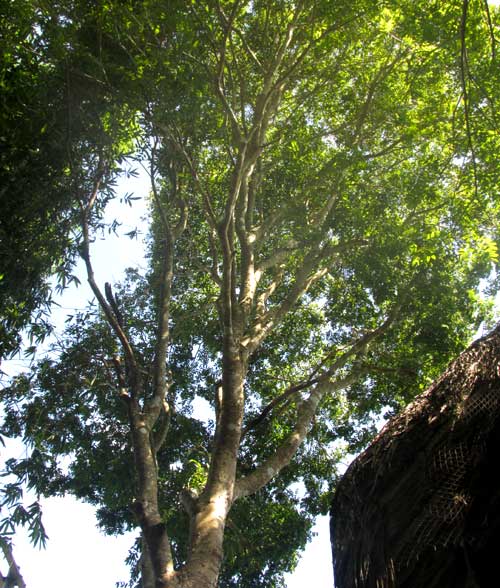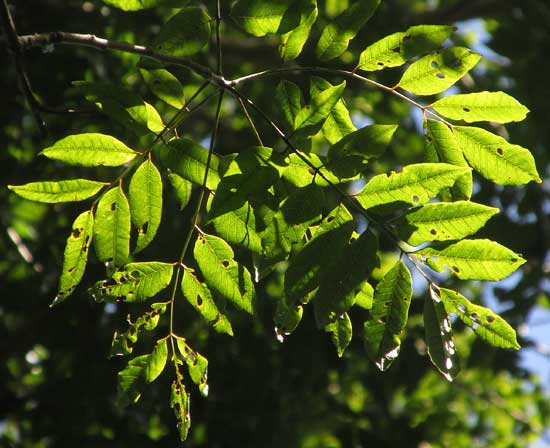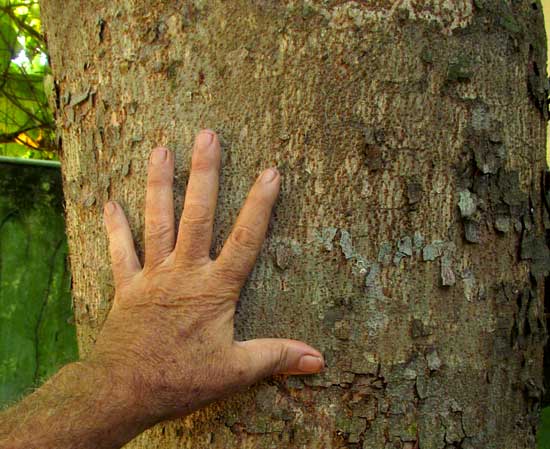Excerpts from Jim Conrad's
Naturalist Newsletter
from the September 28, 2018 Newsletter issued from Rancho Regenesis in the woods ±4kms west of Ek Balam Ruins; elevation ~40m (~130 ft), N~20.876°, W~88.170°; central Yucatán, MÉXICO
ASTRONIUM/ KULINCHÉ
The rancho's owner operates Genesis Eco-Resort in the little village of Ek Balam, where I bike a couple times each week to recharge my computer batteries. The resort's grounds, though small, host an amazing assemblage of ornamental and native plants. I'm developing a Plant Find Guide for visitors so they can wander around, identify the plants, and read a little about them. The largest of all the plants within the compound's walls is a fine shade tree that looms over all others plants and buildings. Thing is, at first I didn't know what it was. Below, you can see a view up through its gracefully spreading limbs:

Our area is so arid that few trees grow this tall. This one must have been there when the resort was established, and maybe it's benefited from living within the resort's stone walls. The tree's leaves were all too high for a close look, but with a telephoto lens and PhotoShop I managed to see that the leaves were pinnately compound, looking somewhat like Pecan or hickory leaves, as shown below:

The only part of the tree affording a close look was the massive trunk, its bark shown below:

The bark is somewhat smooth, gray-brown, with isolated groups of small, squarish flakes loose on one end, arranged in irregular patterns.
These details weren't enough for me to make an identification, so in desperation I asked Don Enicio, one of the Maya workers, if he knew what it was. As if speaking of an old friend, he said, "It's Kulinché."
That happens a lot, and it's frustrating because usually the Maya names can't be traced to any particular species known by science. The Maya often give the same names to many look-alike plants, plus one species with different appearances may bear several names, and even the Maya view of plants is different from the scientific one, so name-giving goes by different rules according to them. For example, if one of two similar looking species habitually grows smaller than the other and bears more slender branches, it may be regarded as the female and the other the male, with both having the same name. That the "male" also produces fruit doesn't matter.
But, this time, having no better option, on the Internet I looked up Kulinché, and found an anthropological study of traditional Maya plant uses in which Kulinché was mentioned as an important timber tree. It was identified as ASTRONIUM GRAVEOLENS, a member of the Cashew/Poison Ivy Family, the Anacardiaceae. On the Internet, pictures of leaves and bark of Astronium graveolens couldn't better match ours, right down the the little squarish flakes loose on one end, arranged in irregular patterns.
Probably I haven't noticed Kulinché until now because, unlike Don Enicio to whom the growth form and bark were the main features, I need flowers and fruits so that technical descriptions can be used. And this tree's flowers and fruits appear so high up that I've simply never noticed them.
Kulinché is an important tree, famed for its well formed, strong wood, which is exported to many countries as a "tropical hardwood." It is durable, weathers well, is highly resistant to moisture absorption, and takes an excellent polish. I read that it's so overharvested in the wild that it's losing ground fast. With good growing conditions it can grow 30m tall (100ft) and its trunk can measure 100cm in diameter (3.3ft)
Kulinché has no commonly accepted English name, and of course its Maya name isn't used in other cultures throughout its distribution area extending from the moist lowlands of central Mexico south through all of Central America and most of South America. It's a "canopy tree," meaning that in well developed forests it's among the taller species. At its base enormous flaring buttresses often are formed.